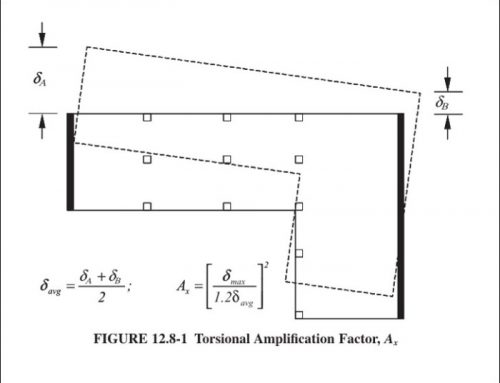Question:
Why the Location of Center of Rigidity Changes for Each Story Even for Symmetric Structures?
Answer:
The center of rigidity is the center of resistance of a floor or diaphragm against lateral forces. It is the stiffness centroid located within a floor-diaphragm plan. If the lateral forces are applied at this center, the floor diaphragm will experience only the translational displacement (i.e. no rotation). Other levels are free to translate and rotate since the actual behavior is coupled both in plan and along height. The location of center of rigidity is an inherent structural property and has nothing to do with applied loading. The information about its location is important to calculate design-eccentricity while performing code-based seismic analysis.
Beside the analysis results, the ETABS and other structural analysis software also report the center of rigidity as an output. For a given floor diaphragm, the CSI’s analysis reference manual describes the process of calculating the center of rigidity as follows:
Case 1: A unit load is applied to an arbitrary point in global X direction such that the diaphragm rotates about vertical (Z) direction. The rotation of diaphragm (Rzx) is determined.
Case 2: A unit load is applied to the same point in global Y direction such that the diaphragm rotates about vertical (Z) direction. The rotation of diaphragm (Rzy) is determined.
Case 3: A unit moment about global Z direction is applied to the same point. This also causes the rotation of diaphragm about vertical (Z) direction. This rotation (Rzz) is also determined. These three load cases are shown in Figure below.

The location of Center of rigidity (XCR and YCR) is then computed as follows.
XCR = – Rzy / Rzz, and
YCR = Rzx / Rzz
These coordinates (XCR and YCR) are relative to the location of the point at which the three loads cases are applied. If the center of mass of a diaphragm is selected for the application of three load cases, then
XCR = XCM – Rzy / Rzz, and
YCR = YCM + Rzx / Rzz
Where XCM and YCM are the location of center of mass of that diaphragm.
In ETABS, we need to check the option to calculate the Diaphragm Centers of Rigidity. This option is available in Analyze > Set Load Cases To Run. During analysis, ETABS calculates these coordinates for each floor diaphragm if the diaphragm assignment is present in the model. After the analysis is complete, the Center of rigidity and center of mass can be displayed by selecting Display > Show Tables > Analysis > Results > Structural Results > Centers of Mass and Rigidity > OK.


If the mass is constant as well as uniformly distributed for each story, the location of center of mass (XCM and YCM) for each story will be same. Similarly, for a symmetric plan and distribution of stiffness about both horizontal (X and Y) axes, the location of center of stiffness (XCR and YCR) for each story will also be same. This is illustrated in an example below. The cross-sectional dimensions of columns, beams and slabs are same for each story. Both the mass and stiffness of each story are symmetrically distributed about the X and Y directions. We can see that the values of XCM, YCM, XCR and YCR are all same (36 ft). This shows that the center of mass and center of stiffness lies at same location for each story and there is no inherent eccentricity in this model.



However, lets see what happens when we replace one whole line of columns (at the bottom left of plan) with bigger and heavier columns (the cross-sectional sizes are made almost 3 times of the original values).The modified plan and the resulting locations of center of rigidity for each story are shown in the Figures below.


Now, the center of mass of each story is moved slightly towards the bottom right of the plan (i.e. towards the heavier column at each story). However, for each story, its location is still same (37.1068, 34.8932) except the roof which have a different lump mass compare to other stories due to different tributary volume of material.
But what happens with center of rigidity? Similar to center of mass, the center of resistance also shifted towards the heavier column (due to greater lateral stiffness imparted by this column). However, in this case, the location is not same for each story. In fact, it is varying for each story and that variation is plotted in the Figure below.

The XCR values are increasing in a nonlinear manner (from 36.6938 ft to 41.2296 ft) as we move down to bottom. While the YCR values are decreasing in a nonlinear manner (from 35.3062 ft to 30.7704 ft) as we move down to bottom. In plan view, both of these variations correspond to the shifting of center of mass towards the bottom right but in a nonlinear manner along the height of building. This shows that even for regular structures, the center of stiffness (rigidity) for each story may not lie exactly at the same point. Why this is so?
Think of this building as a vertical cantilever column divided into several frame elements (each representing a story). The center of resistance offered by each story may deviate as you move up or down depending upon the coupling of degrees of freedom among the stories and the relative share of lateral forces taken by each structural element within a story. In this case, the locations of both the centers (mass and rigidity) are same for the roof and top few stories. However, as we move down towards the supports, the center of rigidity starts shifting towards the bottom right (i.e. towards the bigger column which is expected to take a bigger share of lateral shear). The story stiffness in X direction itself is varying in a nonlinear manner as shown in the Figure below, i.e. the stories are gradually becoming stiffer in X direction as we move down to supports. The mass, on the other hand, is constant along the height (i.e. same for each story). Therefore, the coordinates of the center of rigidity can be different at each storey even if the cross-sectional sizes, reinforcements and other dimensions are same.

It doesn’t mean that at the bottom floors, the lateral shear taken by bigger column (as percentage of total story shear) is more than the percentage lateral shear taken by the same column at higher floors. In order to investigate this point, let’s first check the story shears under an example lateral seismic loading (equivalent static forces with same acceleration parameters for both models) in the Figure below. The story shears for the model with a bigger column at the corner is slightly higher due to modified seismic weight and story stiffnesses.

Then for both models, the lateral shears is extracted for two corner columns located in X direction font frame as shown in the Figure below. On left side the case for the same column sizes is shown, while on the right, the case for one bigger column on right corner is shown.


Now under the same example lateral loading, the Figure below shows the lateral shear taken by two corner columns (expressed as the percentage of total story shear) located in X direction font frame. On left side the case for the same column sizes is shown, while on the right, the case for one bigger column on right corner is shown.


It is clear that the bigger column is taking a bigger share of total story shear compared to the normal-sized column. However, as we go towards the base, the percentage of lateral shear taken by bigger column is almost constant (or slightly reducing). Therefore, the bigger columns are not attracting more percentage of shears at base and less at top. Note that the increase in column size have drastically modified the horizontal distribution of shears at top and bottom floors with negative values at these floors.
Now let’s compare the normalized values of story shears and story stiffness. The Figure below shows this comparison. Please note that the values are normalized such that the base number is 1.

As we go down the floors, the rate of relative increase in stiffness is not matching with that of story shear. In fact, the story stiffness is a combined result of individual members at material, cross-section and element level. It is also a function of structural configuration. Story shear is a sum of lateral shears taken by all columns. This mismatch indicates that for complex 3D structures, there is no direct and linear relation between story stiffnesses and story shears.
Let’s go back to the basics as an attempt to understand why the location of center of rigidity shifts along the height in case of one bigger column at bottom right of the plan. Remember that the location of center of rigidity is the ratio of two rotations about vertical Z axis (one caused by lateral force in X or Y direction and the other caused by a moment).
It is understandable that with the addition of a bigger column, the location of center of rigidity is expected to shift towards that column. This means that if the case 3 applies a counter-clockwise moment, the rotations resulted in both case 1 and case 2 will be in clock-wise directions. Therefore, if Rzz is positive, both the Rzy and Rzx are negative. The expressions given at start can be used to observe that these rotations will result in shifting the center of rigidity towards the bottom right in plan (XY) view. Now the nonlinear increase in this shift (as we go towards the base) can be explained using the relative contributions of this bigger column in translational and rotational stiffnesses. Although both stiffnesses are a function of height of the building, the location and cross-sectional size of bigger column is resulting in a higher contribution in global rotational stiffness of the building as compared to its contribution in both translational directions. This is resulting in an increase in rotation ratios (Rzx/Rzz and Rzy/Rzz) as we go down towards the base. In other words, the bottom floors are relying more on the bigger column to develop torsional resistance compared to the top floors. Therefore, to completely avoid the floor rotation about the vertical axis, the lateral distance between the bigger column and location of applied forces should decrease as we move towards the base. This explains why the location of center of rigidity shifts along the height.
The models used in this example can be downloaded below.
I hope this information is useful.
Regards
Fawad







Leave A Comment